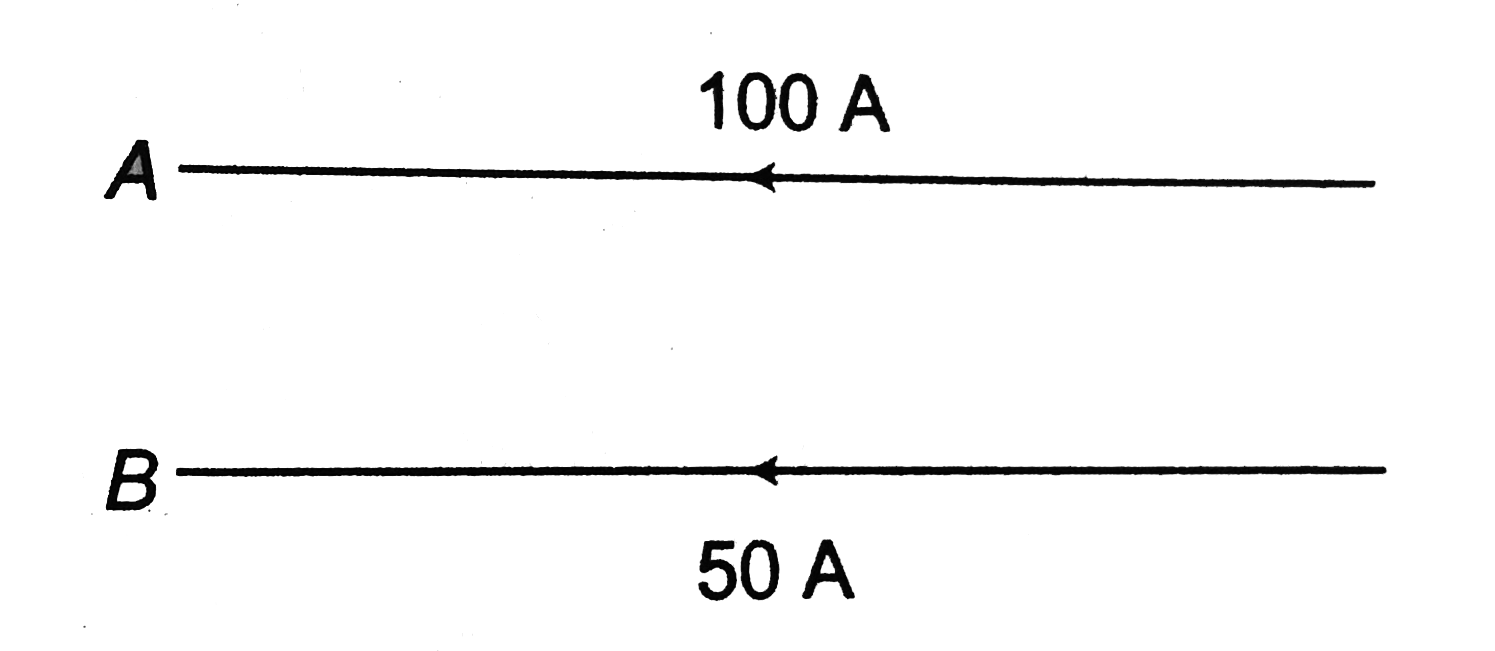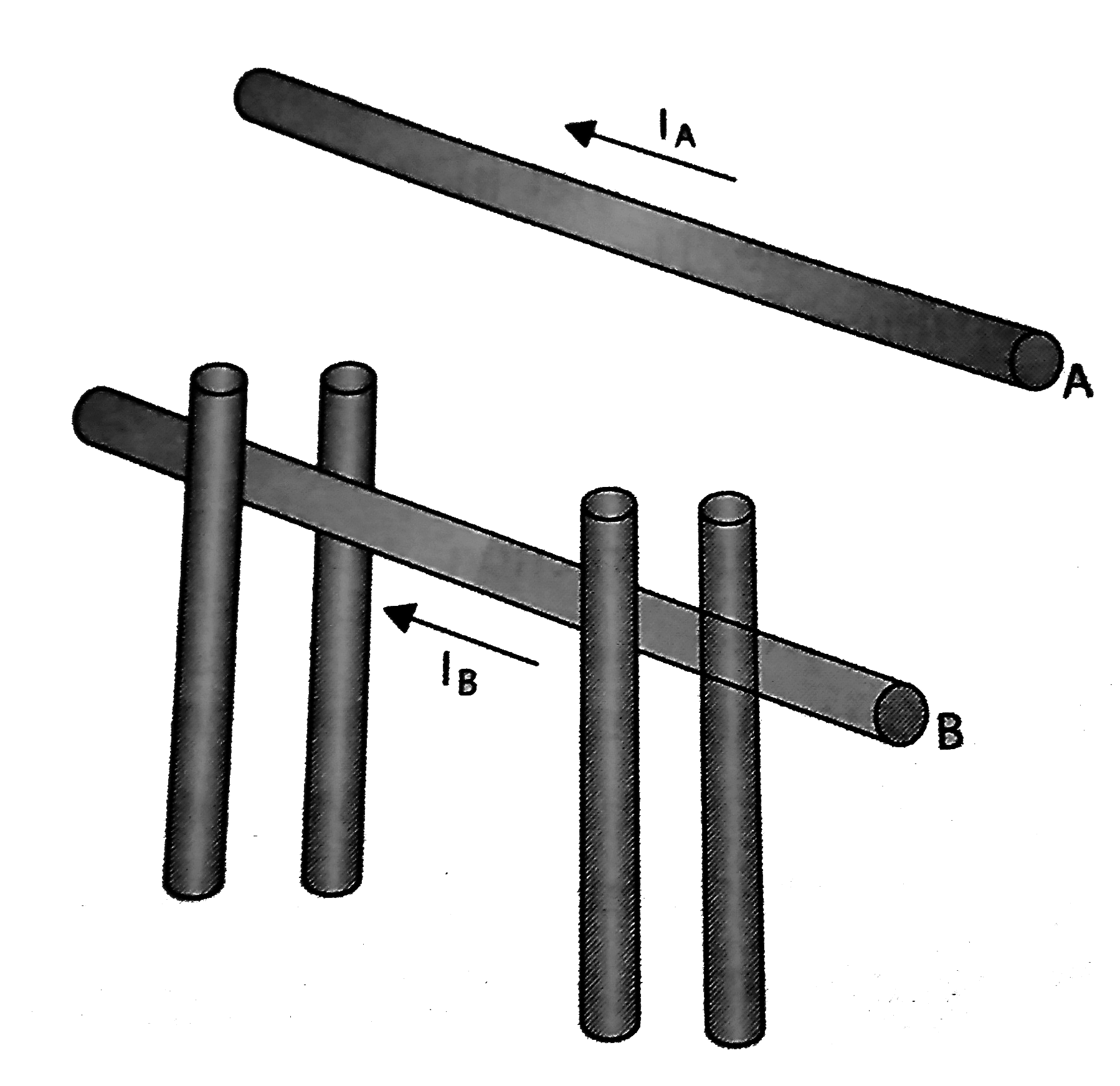The two linear parallel conductors carrying currents in the opposite direction…………………each other.
If both assertion and reason are true and reason is the correct explanation of assertion.
If both assertion and reason are true but reason is the correct explanation of assertion.
If assertion is true but reason is false
If both assertion and reason are false.
The correct Answer is:D
To solve the problem of what happens to two linear parallel conductors carrying currents in opposite directions, we can follow these steps:
Step 1: Understand the Setup
We have two parallel conductors, labeled as A and B. Each conductor carries an electric current, denoted as I1 for conductor A and I2 for conductor B. Importantly, the currents in these conductors are flowing in opposite directions.
Step 2: Apply the Right-Hand Rule
To determine the direction of the magnetic field produced by each conductor, we can use the right-hand rule. For conductor A, if you point your thumb in the direction of the current (I1), your fingers will curl around the conductor in the direction of the magnetic field lines created by that current.
Step 3: Determine the Magnetic Field Direction
- For conductor A (current I1), the magnetic field (B) at the location of conductor B will be directed downwards.
- For conductor B (current I2), if you apply the right-hand rule similarly, the magnetic field at the location of conductor A will be directed upwards.
Step 4: Calculate the Force on Each Conductor
The force experienced by a current-carrying conductor in a magnetic field can be calculated using the formula:
F=I⋅L⋅B⋅sin(θ)
where:
- F is the force,
- I is the current,
- L is the length of the conductor,
- B is the magnetic field strength,
- θ is the angle between the current direction and the magnetic field direction.
In this case, since the angle θ is 90 degrees (the current and magnetic field are perpendicular), sin(90)=1.
Step 5: Determine the Direction of the Forces
- The force on conductor A due to the magnetic field created by conductor B will be directed away from conductor B (upwards).
- Conversely, the force on conductor B due to the magnetic field created by conductor A will be directed away from conductor A (downwards).
Step 6: Conclusion
Since the forces on both conductors are directed away from each other, we conclude that the two linear parallel conductors carrying currents in opposite directions repel each other.
Final Answer
The two linear parallel conductors carrying currents in opposite directions repel each other.
---
We have two parallel conductors, labeled as A and B. Each conductor carries an electric current, denoted as I1 for conductor A and I2 for conductor B. Importantly, the currents in these conductors are flowing in opposite directions.
To determine the direction of the magnetic field produced by each conductor, we can use the right-hand rule. For conductor A, if you point your thumb in the direction of the current (I1), your fingers will curl around the conductor in the direction of the magnetic field lines created by that current.
- For conductor A (current I1), the magnetic field (B) at the location of conductor B will be directed downwards.
- For conductor B (current I2), if you apply the right-hand rule similarly, the magnetic field at the location of conductor A will be directed upwards.
The force experienced by a current-carrying conductor in a magnetic field can be calculated using the formula:
F=I⋅L⋅B⋅sin(θ)
where:
- F is the force,
- I is the current,
- L is the length of the conductor,
- B is the magnetic field strength,
- θ is the angle between the current direction and the magnetic field direction.
- The force on conductor A due to the magnetic field created by conductor B will be directed away from conductor B (upwards).
- Conversely, the force on conductor B due to the magnetic field created by conductor A will be directed away from conductor A (downwards).
Since the forces on both conductors are directed away from each other, we conclude that the two linear parallel conductors carrying currents in opposite directions repel each other.
The two linear parallel conductors carrying currents in opposite directions repel each other.
Topper's Solved these Questions
- BOOK - NCERT FINGERTPS ENGLISHCHAPTER - MOVING CHARGES AND MAGNETISM EXERCISE - Magnetic Force15videos
MOVING CHARGES AND MAGNETISM
- BOOK - NCERT FINGERTPS ENGLISHCHAPTER - MOVING CHARGES AND MAGNETISM EXERCISE - Motion In Magnetic Field6videos
MOVING CHARGES AND MAGNETISM
- BOOK - NCERT FINGERTPS ENGLISHCHAPTER - MOVING CHARGES AND MAGNETISM EXERCISE - EXEMPLAR PROBLEMS6videos
MOVING CHARGES AND MAGNETISM
- BOOK - NCERT FINGERTPS ENGLISHCHAPTER - MAGNETISM AND MATTER EXERCISE - NCERT Exemplar5videos
MAGNETISM AND MATTER
- BOOK - NCERT FINGERTPS ENGLISHCHAPTER - NUCLEIEXERCISE - Assertion And Reason15videos
NUCLEI
Similar Questions
Two long parallel conductors are carrying currents in the same direction as shown in the figure. The upper conductor A carrying a current of 100A is held firmly in position. The lower conductor B carries a current of 50A and free to move up and down. The linear mass density of the lower conductor is 0.01 kg/m.
 View Solution
View SolutionTwo long thin, parallel conductors carrying equal currents in the same direction are fixed parallel to the x-axis, one passing through y = a and the other through y=−a. The resultant magnetic field due to the two conductors at any point is B. Which of the following are correct?
 View Solution
View SolutionTwo long, parallel conductors carry currents in the same direction as shown in Fig. Conductor A carries a current of 150A and is held firmly in position. Condcutor B carries current IB and is allowed to slide freely up and down (parallel to A) between a set of non-coducting guides. If the mass per unit length of conductor B is 0.001gcm−1 , what value of current IB will result in equilibrium when the distance between the two conductors in 2.50cm?

 View Solution
View SolutionTwo long parallel conductors carry currents I and 2I in the same direction. The magnetic induction at a point exactly mid way between them is B. If the current in the first conductor is reversed in direction, the magnetic induction at the same point will be
View SolutionAnswer the following:
(a)Define SI unit of current in terms of the force between two parallel current carrying conductors.
(b) Two long straight parallel conductors carrying steady currents IaandIb along the same direction are separated by a distance d. How does one explain the force of attraction between them? If a third conductor carrying a current Ic in the opposite direction is placed just in the middle of these conductors , find the resultant force acting on the third conductor.View Solution(A) : A helical spring tends to contract, when a current passes through it
(R) : Two straight parallel metallic wires carrying current in same direction repel each otherView SolutionAssertion : Two parallel conducting wires carrying currents in opposite direction, come close to each other.
Reason : Parallel currents repel and anti parallel currents attract.View SolutionTwo long straight parallel conductors 10 cm apart, carry currents of 5A each in the same direction. Then the magnetic induction at a point midway between them is
View SolutionTwo parallel wires carrying current in the same direction attract each other while two beams of electrons travelling in the same direction repel each other. Why?
View SolutionTwo parallel wires carrying current in the same direction attract each other while two beams of electrons travelling in the same direction repel each other. Why?
View Solution

